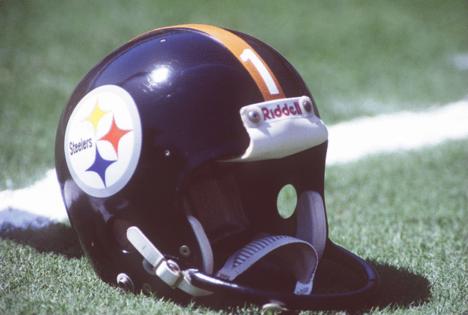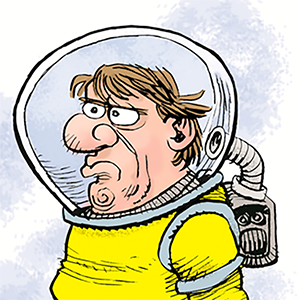Joe Starkey: What about 'other guys' from Steelers 1974 draft? How did their lives turn out?
Published in Football
The 1974 NFL draft was held Jan. 29-30 at the Americana Hotel in New York City. Mel Kiper Jr. and his hair were still a decade away from introducing themselves to America. If the draft was mocked, it was because it lasted 17 rounds, saw 442 players selected and was not televised. The Steelers took 21 players. Of the 17 who did not make the Pro Football Hall of Fame, two have died — UCLA cornerback Jimmy Allen in 2019 and Prairie View A&M defensive tackle Jim Wolf in 2003. The 15 others took varied paths in life, often quite interesting ones.
———
Some names from the Steelers’ legendary 1974 draft class still stand out.
Dickie Morton.
Octavus Morgan.
Hugh Lickiss.
Those names are hard to beat. They probably weren’t the ones you were thinking of, but let’s be honest: You already know the Jack Lambert, John Stallworth, Mike Webster and Lynn Swann stories. You know undrafted free agent Donnie Shell recently became the fifth Pro Football Hall of Famer from that rookie class, too.
You might not know that 15th-round pick Lawrence “Big Daddy” Hunt asked the Steelers for $100,000, left town for good when they didn’t meet his price and experienced a devastating identity crisis.
You probably don’t know that Eastern Michigan quarterback Frank Kolch, a 13th-round pick, also refused to sign a contract, and that ninth-rounder Tommy Reamon, a running back out of Missouri, bolted for the World Football League and would later land a role on the iconic television series “Charlie’s Angels,” starring Farrah Fawcett, Kate Jackson and Jaclyn Smith.
“Talk about a Hall of Fame group,” Reamon says.
I’m here to tell you about those guys — the “other guys” from the ’74 draft. The ones most people don’t remember or never knew of. How did their lives turn out? What was their experience toiling under coach Chuck Noll and banging heads with Mean Joe Greene and Franco Harris during those brutal months in Latrobe?
The summer of ’74 was an unusual one at St. Vincent. Famous author James Michener was there, working on a book about sports and culture, but the Steelers veterans were not. They missed the first month-plus on account of a players strike, a fact Greene believes helped the team win its first Super Bowl that year.
The rookies, you see, had the run of camp for something like 50 practices, usually two per day.
“Those guys made a tremendous contribution that year, and I’ve always thought it was because they had a chance to get more reps during camp, because we weren’t there,” Greene says. “They were very, very important.”
Some were, anyway. Others were bit actors. Most never played here. I don’t have all their stories, but I do have some. More like snippets from the lives of a handful of men who even if they never played a down in black and gold can always say they were part of the greatest draft class in American sports history ...
‘Big Daddy’
Lawrence Hunt is the bionic man. He’s had both hips and his left knee replaced and is awaiting a new right shoulder. Yet he plays golf three times a week. He also is a man at peace — and that was decidedly not the case when he bolted Pittsburgh 50 years ago.
Hunt and his father flew in after the draft and met with Dan Rooney. A defensive lineman out of Iowa State, Hunt felt the NFL’s financial hierarchy was unfair. Once the stars got paid, there wasn’t much left. He cringed when he heard his fellow rookies whooping it up in their hotel rooms after signing paltry rookie deals. He asked the Rooneys for $100,000 and wasn’t taking a penny less, even if he was a 15th-round pick.
“One of the assistants pulled me aside and said, ‘We don’t pay linemen that kind of money,’ ” Hunt recalls. “They offered $40,000 with incentives to bring it to my number. I wasn’t going to take that. I said, ‘If I’m gonna move my wife and child from Ames, Iowa, to Pittsburgh, I don’t want to be poor.’ ”
Hunt returned to his room and told his father he was ready to go home.
“He said, ‘Lawrence, are you sure?’ ” Hunt recalls. “I said, ‘Absolutely, pops. If they’re not gonna pay me what I think I’m worth, there’s no reason to stay.’ ”
Upon his return home, Hunt floundered. Back at Iowa State — where Johnny Majors had a pretty good coaching staff featuring Jackie Sherrill and Jimmy Johnson — Hunt earned his “Big Daddy” nickname with 334 career tackles.
Who was he without football?
“I didn’t know how hard it would be,” Hunt says. “I was always that name — Big Daddy — with a number on my back. I wasn’t sure what to do. I checked into a local counseling group and said, ‘I don’t know what’s going on with me, but I don’t feel like myself.’ ”
The crisis didn’t last. Hunt, 72, went on to a successful career in business and ultimately in service of others. He was a child-abuse investigator and still works with at-risk youth in his small Florida town an hour from Tampa. He’d grown up a Florida kid and vowed to return to help make it a better place.
It’s kind of a Moonlight Graham story — an aspiring athlete who misses his big chance but helps society in much more significant ways. One look at a photo of a beaming Hunt posing with his grandchildren tells you he doesn’t spend much time thinking about what might have been.
But he does spend some. He could have been part of the Steel Curtain.
“You can’t help but look at it and ask yourself, would I have measured up to those guys? Was I good enough, fast enough and strong enough? That’s a question I’ll never, ever be able to answer — but life has worked out pretty good for me.”
‘I never quit’
Fans kept mistaking him for Terry Bradshaw. Hugh Lickiss didn’t mind. A long-shot, blonde-haired linebacker from tiny Simpson College in Indianola, Iowa, he just wanted to stick around — and that idea was suddenly in grave doubt as Chuck Noll yelled in his face with Franco Harris lying on the ground.
You weren’t supposed to tackle Franco at training camp. Lickiss just had. The two accidentally smashed into each other. Noll went nuts.
“I thought, ‘I’m done. I’m out of here right now,’” Lickiss recalls with a laugh from his home in Iowa.
Like others from his class, he is a doting grandfather now after a successful career as a traveling sales rep. His daughter was an All-American volleyball player at Drake. His son was an international opera singer. They both grew up Steelers fans thanks to their dad.
If Lickiss closes his eyes, he remembers all of it: the call from his dad, while returning from studying abroad in Germany, that he’d been drafted in the 12th round; the introductory rookie dinner on Mt. Washington; the first words from Noll (“Obviously, we picked all you guys because we’re confident in your ability and talents”); walking into Three Rivers Stadium and feeling like an alien; the heated battles in camp, where he was moved to defensive line at just 225 pounds (the linebacker room was kind of crowded, not that the defensive line room wasn’t); the long walk up to Noll’s office before the final preseason game, knowing he’d be cut; the silent bus ride from the William Penn to the airport with all the other final cuts; the hamstring injury that cut short a tryout with the Detroit Lions.
And he wouldn’t trade any of it.
“I was always taught, don’t quit. Well, I never quit,” Lickiss says. “Your time is just up. The sad part is looking back at a lot of those teammates no longer around. We lost quite a few of those guys — of the defensive linemen, Joe Greene is the only survivor right now. When you think back, god, 50 years. It doesn’t seem like it was that long ago.”
‘No prisoners’
Charlie Davis has stories. Good ones. Not necessarily ones that jibe with Mean Joe Greene’s memories, but hey, it was 50 years ago.
Davis remembers the rookies quickly developing a deep belief in themselves. Swann, Lambert, Webster, Stallworth and the others, including Davis, a ninth-round defensive tackle from TCU, were ready for action by the time Greene & Co. reported.
In fact, Davis remembers fellow rookie Jimmy Allen refusing Greene’s request to “get him some shrimp” at a camp dinner, resulting in a plate flying at Greene’s head. Greene doesn’t remember it that way. He says the shrimp incident happened a year or two later.
Either way, things were getting spicy at Steelers camp.
“We were ready to go one-on-one with anybody,” Davis recalls. “I remember Mike Webster doing his thing, and Joe Greene saying, ‘One more time,’ after Webster blocked him, and Chuck Noll saying, ‘No, you only get one shot.’ Those guys didn’t know anything about us, but we knew a lot about them. We just went off. Noll was smiling the whole time. He knew what he had.”
Greene would quickly become an object of admiration, of course, and one snapshot from Davis’ only season in Pittsburgh — he would earn a Super Bowl ring, get traded to St. Louis and enjoy a productive NFL career — stands out. The Steelers began their exhibition season against the New Orleans Saints at Tulane Stadium, which is where they would finish their season, too: in the Super Bowl against the Minnesota Vikings.
Davis will never forget lining up in the tunnel for the Super Bowl. The teams stood only a few feet away in the cramped college stadium.
“I was (Number) 77, Joe was 75, Dwight White was 78, right behind me,” Davis says. “Well, Joe started calling (Vikings defensive end) Alan Page — ‘Hey, Alan, we ain’t taking no prisoners today.’ I was like an observer to history, thinking like, ‘Oh my god, I can’t wait to see what happens.’ And it was total domination.”
One of the first Black athletes to graduate from the TCU Neeley School of Business, Davis became a successful executive and father. He helped open the first Houston chapter of the NFLPA. He periodically joins a Zoom call of Steelers alumni, one that includes Charlie Batch, Jon Kolb, Terry Hanratty and Greene, among others.
And there’s one other story he loves to tell: the one about legendary Steelers scout Bill Nunn marveling at the size of his hands.
It was Nunn who worked out Davis at TCU.
“He was irritating as hell, always on you, but you couldn’t help but like him,” Davis recalls.
Decades later, Davis visited Steelers camp one year and was in a dark room watching film when Nunn walked in.
“He said, ‘I heard somebody’s in here from Texas, and if it’s who I think it is, I gotta know one thing.’ He shook my hand and said, ‘Oh yeah, only one person in the world has hands like that.’ ”
Hometown kid
Mike Webster wasn’t finished with his work day. Never mind that Webster and his new buddy, Rick Druschel, had just spent two hours practicing on brand new artificial turf in blazing hot Lubbock, Texas, in advance of a college All-Star game, with Johnny Majors running the drills (Majors keeps popping up in these stories).
“My feet were burning, and I just wanted to get inside and get a shower,” Druschel recalls. “Mike looked at me and said, ‘You wanna go lift weights?’ I’m thinking, my god, this guy is an animal.’ So we lifted weights for an hour.”
The Steelers drafted both players, who had plenty in common, including the fact that both their wives were named Pam. Getting picked by the hometown team was a dream come true for Druschel, a Greensburg native and Hempfield High School grad who starred at North Carolina State under Lou Holtz. It felt like it was meant to be, too, given that he’d gotten married two years earlier on the day of the Immaculate Reception. The Steelers took him in the sixth round, one round after Webster, who became arguably the greatest center in NFL history.
Webster lived with Druschel and his wife in Greensburg during their first training camp, not knowing if he would make the club.
Druschel remembers Webster telling him, “I just want to play five years.”
The two hulking linemen would cram into Druschel’s Volkswagen Super Beetle for rides to practice. Druschel managed to stick around for a season, which happened to be the greatest season in Steelers history. They finally won the Super Bowl. His father drove a motorhome all the way to New Orleans to watch the game, in which Druschel played special teams.
Like so many, Druschel’s pro football story was one of pain and near misses. He was among the Steelers’ final cuts in 1975, then got hurt trying out with the Winnipeg Blue Bombers of the CFL. Holtz, just hired as coach of the New York Jets, offered him a job but the NFL nixed the deal, citing a rule outlawing players who’d joined another league in the same calendar year.
Druschel wasn’t devastated. He had a Super Bowl ring, after all. He went on to become an educator, coach, athletic director and official (he still officiates pee-wee games), among other vocations. He and his wife raised two daughters and still live in Greensburg. Like Lawrence Hunt, he became an advocate for troubled kids.
Druschel, 72, ended our conversation as he was about to pick up his two young granddaughters.
“Enjoy it,” I said.
“I do, buddy,” he said. “Every day.”
A look at the rest
After Swann, Stallworth, Lambert, Allen (who won two Super Bowl rings here and had an outstanding NFL career), Webster, Wolf (part of the ’74 Super Bowl team) and Druschel, the rest of the ’74 draft class looked like this:
— 7A: Allen Sitterle, offensive tackle, N.C. State: Cut in training camp, became legendary high school coach in South Carolina, where he was enshrined in state’s football coaches Hall of Fame. Still coaching.
— 7B: Scott Garske, tight end, Eastern Michigan: Didn’t make the team as a rookie, inducted into Eastern Michigan Hall of Fame in 2012.
— 8: Mark Gefert, linebacker, Purdue: North Braddock star didn’t make team as a rookie, became CFL star in Winnipeg.
— 9A: Tommy Reamon, running back, Missouri: Won WFL MVP after turning down Steelers offer, played one season for the Kansas City Chiefs, became an actor who starred in “North Dallas Forty,” then a hugely successful high school coach who is still coaching in Newport News, Va.
— 9B: Davis.
— 10A: Jim Kregel, guard, Ohio State: Did not make team. Blocked for Archie Griffin in college. Played in WFL.
— 10B: Dave Atkinson, defensive back, BYU: Did not make team, still BYU’s all-time leader in interceptions (20).
— 11: Dickie Morton, running back, Arkansas. Did not make team, played in CFL.
— 12: Lickiss.
— 13: Frank Kolch, quarterback, Eastern Michigan. Declined to sign a contract. Remains one of only two EMU quarterbacks drafted, the other being Charlie Batch.
— 14: Bruce Henley, defensive back, Rice: Did not make team after he was a two-sport star at Rice, also a pitcher for baseball team.
— 15: Hunt.
— 16: Octavus Morgan, linebacker, Illinois. Did not make team, played in CFL.
— 17: Larry Moore, defensive end, Angelo State. The Steelers’ final pick, at No. 437 overall, did not make the team after playing fullback, tight end and defensive end in college.
©2024 PG Publishing Co. Visit at post-gazette.com. Distributed by Tribune Content Agency, LLC.







Comments